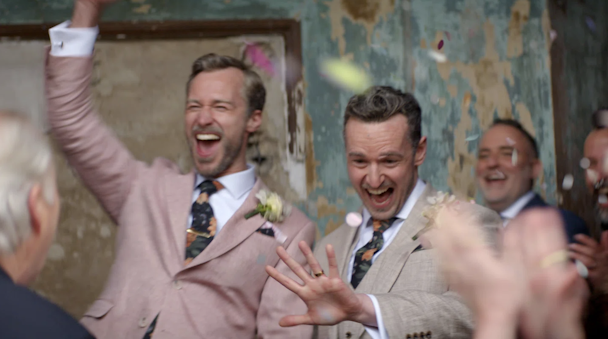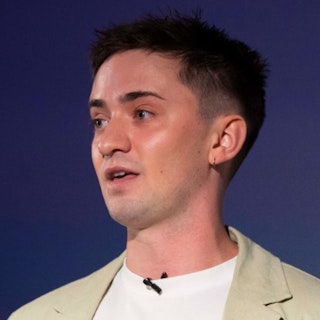Don’t make gay ads for the gays, make gay ads for profit
System1’s Andrew Tindall conducts research with 250,000+ UK consumers to bring some effectiveness evidence to the LGBTQ+ marketing chat.

The National Lottery's 'Pockets' ad from June 2023 follows Edward and Isaac's relationship / National Lottery
I usually bash out a column in an hour. This one took me a month. It’s something I’ve wanted to explore since that Bud Light incident. Something that, as a gay effectiveness researcher and marketer, I’m intensely interested in. But something that is far from simple and needs to be approached thoughtfully.
I’m, of course, talking about ‘gay ads.’
Like most worthy things in life, this was prompted by a chat over some drinks with Mark Ritson and Tamara Littleton at Cannes. A marketing purpose chat popped up, specifically with an LGBTQ+ lens, and we all agreed the story and evidence so far had been rather… lacking.
Recognizing that this is a rather emotional topic to address, some obvious questions that still need answering with ‘gay ads.’ Do brands make enough of them? Do they have a positive influence on LGBTQ+ people’s lives? Is it all ‘pinkwashing’? And are they profitable for brands?
So, as another Pride month passes, here’s my attempt to bring some effectiveness evidence to the LGBTQ+ marketing chat. All with a little help from my mates Mark and Tamara – and research with 250,000+ UK consumers.
Explore frequently asked questions
What do I mean by ‘gay ads’?
I use this term partly to explain why this topic interests me so much and why it’s important. It’s a term I hear from LGBTQ+ friends and non-LGBTQ+ marketers a lot – often wrapped up in the belief that advertising tries a bit too hard to be inclusive when they’ve spotted an ad featuring someone who is clearly LGBTQ+.
A gay ad is one that clearly shows LGBTQ+ people or their culture. As simple as including them in the narrative, to making the entire narrative about them. From two women holding hands in the background of a shot to the story of a gender transition being the entire focus of a creative idea.
Calling these ads ‘gay’ isn’t an issue. Quite like ‘queer,’ LGBTQ+ people have positively reclaimed these words. What does make me uncomfortable, however, is the subtle but omnipresent belief that advertising tries a bit too hard to be LGBTQ+ inclusive. This is all a product of marketers screaming for 10 years that focusing on socio-cultural purpose will make consumers jump through fire to buy your brand, while now the popular belief that brands focus too much on ‘doing good’ and not making a profit.
The usual pro-LGBTQ-inclusion pushback primarily focuses on two things. One is the oft-cited research that *insert large number here*% of Gen Z consumers claim they will pay more for a brand if they show support for a social cause they care about. And two is the unwavering belief that LGBTQ+ visibility in ads makes life better for LGBTQ+ people.
My issue with these two arguments to date are any marketers that’s been trained in the dark arts of evidence-based marketing will quickly point out that consumers claiming they will do something has nothing to do with what they will actually do. And I’ve never seen any actual evidence that visibility makes life better for LGBTQ+ people. Sure, it seems intuitive, but intuition leaves itself open to personal opinions such as ‘action, not visibility,’ saying brands need to put their money where their mouth is to make it authentic or not bother with visibility at all – an opinion Ritson quickly shared at Cannes and has talked about his column this week.
This worries me. With a mishandling of an LGBTQ-focused campaign “costing AB InBev $395m” and some people pushing for no visibility without action, there’s an easy conclusion for brands to get to: let’s just not bother including the gays at all.
As someone who can happily walk about London holding his boyfriend’s hand, any conclusion that could mean fewer people feeling this comfortable in the future is, well, horrific.
I hope data and effectiveness research can be the guiding light to ensure this doesn’t happen.
Finding 1: UK advertising massively underrepresents LGBTQ+ people
To understand if advertisers are trying to push the gay agenda a little too hard, we first must understand how much of the population actually identifies as LGBTQ+. Here, Outvertising has done a fantastic job in its 2023 consumer report. With YouGov data from 230,000+ people living in Great Britain (aged 18+), it showed that 9% of the UK population actively identify as LGBTQ+, with nearly 25% of Gen Z actively identifying as LGBTQ+. Generally, the younger you are, the more likely you are to identify as LGBTQ+. This is already an interesting insight for a marketer who wants to grow with Gen Z.
To understand how many ads visibly feature LGBTQ+ people, we dipped into the System1 creative effectiveness data. We test every ad that airs on UK TV with nationally representative consumers to measure the emotional and brand response to campaigns. Our amazing research team took every ad aired over the past four Junes and coded them to determine whether their main theme/focus was LGBTQ+ culture, people, characters or narratives, or whether they simply visibly included an LGBTQ+ person.
Amazingly, only 2.5% of advertising features LGBTQ+ people. And only a quarter of those ads had a main LGBTQ+ theme.
When you remove those that “rather not say” from the YouGov data, you can clearly see just how UK TV advertising underrepresents LGBTQ+ people. Depending on which age group, it’s anywhere between two-to-ten-fold underrepresentation.
Sure, there are some nuances here. This is UK TV advertising and doesn’t include digital, which you’d assume would be more representative due to the common belief that it skews more Gen Z. And as Ritson also shared in his article, a bisexual man buys a burger just like anyone else. The 97.5% of ads that don’t feature LGBTQ+ people aren’t anti-LGBTQ+ or inherently heterosexual. Gender and sexuality just aren’t always relevant in advertising. The flip side to that is all the assumed tropes that advertising uses, especially the ‘boy meets girl’ story and what a family is supposed to look like. But I won’t get into that here…
Advertisement
Finding 2: Unsurprisingly, visibility matters for LGBTQ+ people
That same Outvertising report showed LGBTQ+ people are still 10 times more likely to experience discrimination based on their sexuality compared with heterosexual males. It’s a pretty shocking fact if you check the date at the bottom right of your PC screen and remember the year is 2024.
Does LGBTQ+ visibility help here? Does it make LGBTQ+ people more widely accepted? I’ve had to do my least favorite thing to answer this: refer to academic literature.
If you’ve ever binged Netflix to the point where you feel you know, like or love a character in the show, you have experienced something called a ‘parasocial relationship’ – something that was first described in 1956, back when media played a tiny role in people’s lives compared with now. These relationships can tremendously impact your life outlook, beliefs and values. There’s an incredibly well-researched and substantiated idea called the ‘parasocial contact hypothesis,’ where contact with people from ‘outgroups’ (people that are different from them, like LGBTQ+ here) reduces prejudice.
Mere exposure to LGBTQ+ through media (including advertising) educates on issues, reduces anxiety among non-LGBTQ+ people and increases empathy and perspective. There’s peer-reviewed research showing how this contact with LGBTQ+ people reduces prejudice towards them and even how contact between lesbian/gay people and bisexual people reduces bisexual negativity. That’s right, LGBTQ+ contact even makes the gays nicer.
This academic research clearly shows how even simple contact via media and ads with LGBTQ+ visibility changes attitudes toward LGBTQ+ people for the better. Visibility matters. Ads doing it make LGBTQ+ people’s lives better. Sure (like all social or purpose messaging), it’s more authentic and builds more trust if claims are followed with some sort of action. But visibility shouldn’t be shrugged off.
Finding 3: Gay ads make brands more profit
We then analyzed the emotional response to all the ads with LGBTQ+ visibility versus those without, which is emotional data for 250,000ish consumers. Because there were so few, we even had to run an additional study to find more ads with LGBTQ+ visibility and tested them with an additional audience of 1,800+ LGBTQ+ consumers to dive deeper into the insights.
If putting people who are LGBTQ+ into advertising is damaging to advertising effectiveness, we’d need to see an adverse emotional response to these ads from a broad audience and a change in our emotion-based creative effectiveness metrics. Not only did we not see this, but we saw ads with LGBTQ+ visibility score higher with LGBTQ+ consumers, causing increased emotional engagement and brand positivity. This is rather consistent with System1 and ITV’s previous research looking at minority representation in advertising in general, Feeling Seen.
Gay ads are as effective as any other ad with broad audiences and are much more effective with LGBTQ+ audiences. LGBTQ+ visibility is a net positive for advertising effectiveness.
This is a powerful new finding. Stemmed from an open and curious question posed by Tamara, met with an open and honest ability to be challenged by Ritson. We aren’t citing a survey with people claiming they will throw cash at LGBTQ+-friendly brands. We are accepting that the general public doesn’t really care if they see LGBTQ+ in ads, but there’s a huge benefit for brands with LGBTQ+ consumers. And a huge real-world benefit to the lives of these consumers.
And this is before even thinking about how marrying a powerful social message with creativity and brand consistency can be. But that’s probably for a chat over more wine sometime in the future. For now, I’ll leave you with my favorite example of an ad achieving exactly that while featuring an LGBTQ+ person. Oh, and the emotional response for a group of LGBTQ+ US consumers. Grab the tissues and enjoy.
As with most of my research, you can get the full deck and charts with full citations for free here.
